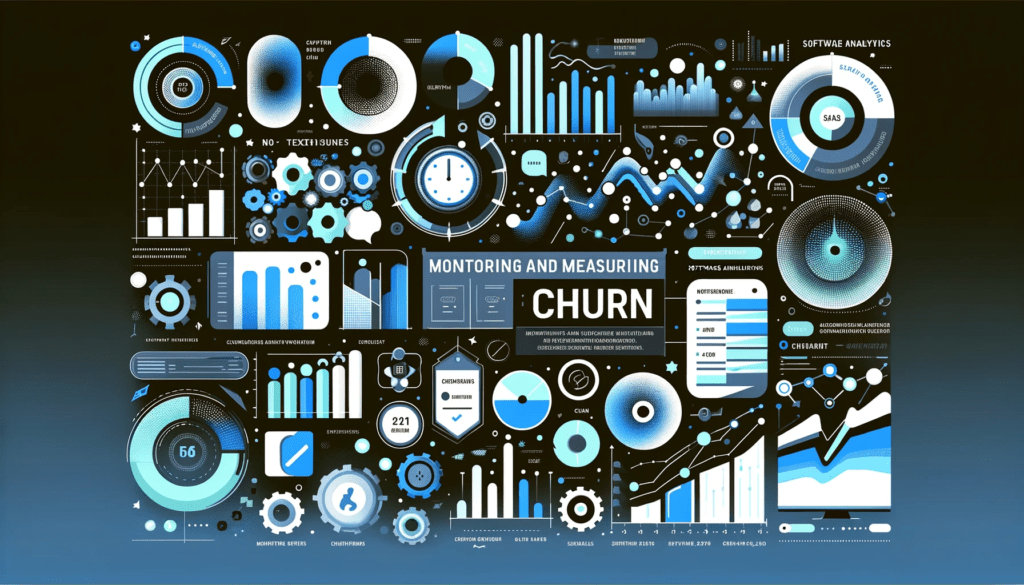
- I. The Importance of SaaS Churn Reduction
- II. Understanding SaaS Churn
- III. Common Reasons for Churn
- IV. The Role of SEO in Customer Retention
- V. Content Marketing and Churn Reduction
- VI. Onboarding and User Experience
- VII. Communication and Feedback
- VIII. Monitoring and Measuring Churn
- IX. Conclusion
- X. Ready to Reduce Churn Rates?
I. The Importance of SaaS Churn Reduction

In the fast-paced world of Software as a Service (SaaS), where customer loyalty is a prized possession, reducing churn rates is of paramount importance.
Churn rates, which represent the percentage of customers who cancel their subscriptions within a specified time frame, can have a profound impact on a SaaS company’s revenue and customer base.
This is where SEO (Search Engine Optimization) steps in as a powerful ally. In this section, we’ll delve into the significance of SaaS churn rates and the pivotal role that SEO plays in mitigating them.
Churn rates, often referred to as “churn,” are more than mere numbers; they are the lifeblood of any SaaS company. Understanding and addressing churn is vital for sustaining a healthy business.
On the other hand, SEO is the art and science of enhancing your online presence, driving organic traffic to your website, and improving your search engine rankings.
At first glance, the connection between churn rates and SEO may not be obvious, but as we explore further, you’ll discover how SEO strategies can be employed to boost customer retention and reduce churn effectively.
Next, in Section II, we will delve deeper into the world of SaaS churn rates, defining what they are and examining their impact on a company’s revenue and customer base. Understanding the magnitude of the challenge is the first step toward overcoming it.
II. Understanding SaaS Churn

Defining SaaS Churn Rates
Before we dive into the strategies for reducing churn rates, let’s define what SaaS churn rates actually are. In the world of subscription-based services, churn rates represent the percentage of customers who cancel their subscriptions during a specific period.
These cancellations can occur for various reasons, such as dissatisfaction with the service, changing business needs, or economic factors.
Impact on Revenue and Customer Base
Understanding churn rates is essential because they have a direct impact on a SaaS company’s revenue and customer base.
When customers leave, it not only results in an immediate loss of revenue but also disrupts growth prospects.
Moreover, acquiring new customers to replace the churned ones can be significantly more expensive than retaining existing ones.
High churn rates can signal underlying issues within your SaaS company, affecting its long-term sustainability and profitability.
As such, keeping churn rates in check is not just a matter of financial prudence; it’s critical for the very survival and growth of the business.
Next, we’ll explore some of the common reasons why customers churn, shedding light on the factors that drive this phenomenon and examining real-world examples to illustrate these points.
Understanding these reasons is the first step in devising effective strategies to combat churn and keep your customers satisfied and engaged.
III. Common Reasons for Churn

Identifying Key Churn Factors
Understanding why customers churn is pivotal in developing strategies to reduce it. Common reasons for churn can vary but often revolve around issues related to value, service, or communication. Let’s delve into these factors:
- Lack of Value: If customers perceive that your SaaS product doesn’t provide sufficient value for the price they pay, they’re more likely to churn. They expect to gain benefits that outweigh the costs.
- Poor User Experience: Difficulties in using your software or encountering frequent bugs can be major turn-offs. Customers want a smooth and hassle-free experience.
- Competitor Offerings: If a competitor offers similar features at a lower price or with better performance, customers might jump ship.
- Lack of Engagement: Customers who don’t actively use your product are at risk of churning. If they’re not engaged, they’re less likely to see the value it brings.
- Communication Gaps: If your communication is infrequent or doesn’t address customer needs and questions effectively, it can lead to frustration.
Real-World Examples
To illustrate these churn factors, let’s consider a few real-world examples.
- Imagine a small business using a SaaS project management tool. They discover that a competitor offers a similar tool with advanced features at a lower price. The cost-benefit analysis prompts them to switch.
- In another scenario, a SaaS company fails to engage its users with meaningful content or updates, leading to decreased product usage and eventual churn.
- Additionally, imagine a situation where a customer encounters frequent technical glitches in a software product. Frustration mounts, and they decide to look for a more reliable alternative.
These examples underscore the critical importance of addressing these churn factors.
In the upcoming sections, we’ll explore how SEO strategies and other techniques can be harnessed to mitigate these issues and enhance customer retention.
IV. The Role of SEO in Customer Retention

Leveraging SEO for Customer Engagement
In our previous sections, we’ve explored the significance of understanding churn and identified key factors contributing to it.
Now, let’s delve into the pivotal role that SEO plays in retaining SaaS customers and mitigating churn.
Effective SEO practices can substantially improve customer engagement and reduce churn rates. Here’s how:
- Enhanced Visibility: SEO ensures that your SaaS product or service is discoverable online when potential customers search for relevant solutions. This increased visibility can lead to a higher influx of potential customers.
- Targeted Traffic: SEO allows you to target specific keywords and phrases that are relevant to your SaaS offering. This ensures that the traffic coming to your website consists of users genuinely interested in your product.
- Quality Content: SEO often goes hand in hand with content creation. By optimizing your content for search engines, you not only improve your website’s search rankings but also provide valuable information to your audience.
- Improved User Experience: SEO involves optimizing your website’s structure, navigation, and loading speed. This results in an overall better user experience, making it easier for visitors to find what they’re looking for and engage with your product.
- Keyword-Driven Insights: SEO tools can provide valuable insights into the keywords and phrases your target audience uses. This knowledge can inform your content strategy and help you address their needs effectively.
Strategies to Reduce Churn
Now that we’ve established the importance of SEO in customer retention, let’s explore specific strategies to leverage SEO effectively:
- Content Optimization: Create high-quality, informative, and engaging content that addresses the pain points and needs of your target audience. Optimize this content with relevant keywords to attract organic traffic.
- User-Focused Content: Tailor your content to your audience’s preferences. Understand their challenges and create content that resonates with their needs, making them more likely to stay engaged.
- Technical SEO: Ensure that your website is technically sound. Fast-loading pages, mobile responsiveness, and easy navigation all contribute to a positive user experience.
- Keyword Research: Conduct thorough keyword research to identify the terms and phrases your potential customers use in search queries. Create content around these keywords to capture their attention.
- Local SEO: If your SaaS targets a local market, focus on local SEO strategies. This includes optimizing for location-based keywords and maintaining consistent business listings.
By implementing these SEO strategies, you can enhance customer engagement, provide value, and ultimately reduce churn rates.
In the next section, we’ll explore how content marketing aligns with these efforts to further boost customer loyalty.
V. Content Marketing and Churn Reduction

Creating Value-Driven Content
Now that we’ve explored the synergy between SEO and customer retention, let’s focus on another potent tool in your arsenal: content marketing.
Content is king, and creating value-driven content can significantly contribute to reducing SaaS churn rates.
- Educational Content: Provide your customers with content that educates them about your SaaS product’s features and benefits. By doing so, you help them unlock the full potential of your solution.
- How-To Guides: Craft detailed how-to guides and tutorials that empower your customers to make the most of your product. This not only reduces churn but also enhances their overall experience.
- Use Case Scenarios: Share real-world use case scenarios of how your product solved specific problems for other businesses. This demonstrates your product’s value and relevance.
- Product Updates and Tips: Keep your customers informed about product updates, new features, and tips for optimizing their usage. This proactive approach can foster loyalty.
Content’s Impact on Customer Loyalty
Creating valuable content isn’t just about providing information; it’s about building a connection with your customers. Here’s how content marketing can impact customer loyalty:
- Brand Authority: Consistently delivering high-quality content positions your brand as an authority in your industry. Customers are more likely to trust and remain loyal to authoritative brands.
- Community Building: Encourage discussions and interactions around your content. Engaged customers who feel part of a community are less likely to churn.
- Customer Education: Informed customers are happy customers. Content that educates and solves problems can lead to more satisfied and loyal users.
- Feedback Loop: Use content as a feedback loop. Encourage customers to provide input, suggestions, and ideas through comments and discussions.
Incorporating content marketing into your churn reduction strategy is a powerful way to foster customer loyalty. It’s about providing ongoing value, support, and engagement that goes beyond the initial sale.
In the next section, we’ll shift our focus to the critical stages of onboarding and user experience, highlighting how they contribute to churn rates and what you can do to improve them.
VI. Onboarding and User Experience

Streamlining Onboarding Processes
Effective onboarding is often the first step towards reducing SaaS churn rates. It’s the initial experience that users have with your product, setting the tone for their entire journey. Streamlining this process is crucial.
- Clarity and Simplicity: Simplify the onboarding steps and ensure that users clearly understand what’s required to get started. Ambiguity can lead to frustration and churn.
- Personalization: Tailor the onboarding experience based on the user’s needs and preferences. This can involve asking a few key questions to guide them to the most relevant features.
- Progress Tracking: Provide users with a sense of progress during onboarding. Visual indicators or progress bars can motivate users to complete the setup.
- Interactive Walkthroughs: Consider interactive walkthroughs that guide users through key features. This hands-on approach can help them grasp the product’s value quickly.
Enhancing the User Experience
The user experience (UX) extends beyond the initial onboarding phase. It encompasses the entire journey. Enhancing UX is an ongoing effort that can significantly impact churn rates.
- Responsive Design: Ensure your SaaS product is accessible across various devices and screen sizes. A responsive design adapts to user preferences.
- Speed and Performance: Slow-loading pages or laggy functionality can be a major turnoff. Optimize your product’s speed and performance continuously.
- User-Friendly Interface: Strive for an intuitive and user-friendly interface. Users should be able to navigate and find what they need without frustration.
- Help and Support: Provide readily accessible support resources, such as a knowledge base, chat support, or in-app assistance. Users are more likely to stay if help is readily available.
- Personalization: Use data to personalize the user experience. Suggest relevant features or content based on their usage patterns.
A smooth onboarding process and a positive user experience build a strong foundation for customer retention. When users find value quickly and enjoy using your product, they are less likely to churn.
In the next section, we’ll explore the importance of effective communication and feedback mechanisms in maintaining strong customer relationships and reducing churn rates.
VII. Communication and Feedback

Maintaining Customer Relationships
Effective communication is the cornerstone of any successful SaaS company’s customer retention strategy.
When customers feel heard and valued, they’re more likely to remain loyal. Here’s how you can maintain strong customer relationships:
- Regular Updates: Keep customers informed about product updates, new features, and improvements. Transparency builds trust.
- Educational Content: Share content that helps users get the most out of your product. This can include blog articles, video tutorials, or webinars.
- Personalized Communication: Segment your user base and send personalized messages. For example, you might send targeted emails to different customer segments based on their usage patterns.
- Responsive Support: Offer timely and helpful customer support. Quick responses to inquiries and efficient issue resolution go a long way.
- Surveys and Feedback Loops: Create a feedback loop by actively seeking input from users. Surveys and feedback forms can provide valuable insights.
Gathering Feedback for Improvement
Listening to your customers is essential for reducing churn rates. Their feedback can highlight pain points and areas for improvement. Here’s how to gather and leverage feedback effectively:
- Feedback Channels: Provide multiple channels for customers to share their thoughts. This can include email, chat, and even in-app feedback forms.
- Net Promoter Score (NPS): Use NPS surveys to gauge overall customer satisfaction and identify promoters, passives, and detractors.
- User Testing: Conduct user testing sessions to observe how customers interact with your product. This can reveal usability issues.
- Feature Requests: Encourage customers to submit feature requests. Knowing what they need helps you prioritize development efforts.
- Churn Analysis: Analyze the behavior of customers who churned. Identify common patterns or triggers that lead to churn.
Effective communication and feedback mechanisms not only help prevent churn but also contribute to product improvement. When users see that their input leads to positive changes, they’re more likely to stay.
In the next section, we’ll delve into the importance of monitoring and measuring churn, offering insights into key metrics and analytics that can guide your retention efforts.
VIII. Monitoring and Measuring Churn

Key Metrics and Analytics
Understanding and managing churn rates require data-driven insights. To effectively reduce churn, you need to monitor and measure specific metrics and analytics that shed light on customer behavior and satisfaction.
Here are some key indicators to watch:
- Churn Rate: This is the most direct measure of customer attrition. Calculate it by dividing the number of customers lost during a specific period by the total number of customers at the beginning of that period.
- Customer Lifetime Value (CLTV): CLTV represents the total revenue a customer generates throughout their engagement with your service. A higher CLTV indicates stronger customer relationships.
- Customer Acquisition Cost (CAC): CAC helps you understand how much it costs to acquire a new customer. Compare it to CLTV to assess the efficiency of your acquisition efforts.
- Net Promoter Score (NPS): NPS measures overall customer satisfaction and their likelihood to recommend your service to others. A higher NPS often correlates with lower churn.
- Customer Effort Score (CES): CES gauges the ease with which customers can achieve their goals using your product. Lower effort scores suggest better user experiences.
- Usage Metrics: Track how frequently and extensively customers use your product. Identify power users and those who might need more support or guidance.
- Feature Adoption: Analyze which product features are most and least used. Promote underutilized features to enhance value and reduce churn.
Making Data-Driven Decisions
Monitoring these metrics provides a basis for data-driven decisions. Regularly assess your findings and adjust your strategies accordingly. For example:
- If churn rate increases, investigate possible reasons and take corrective actions.
- If CLTV is low, consider upselling or cross-selling to existing customers.
- If NPS is low, focus on improving customer satisfaction through support and product enhancements.
Data-driven decisions can help you pinpoint problem areas and allocate resources effectively. Keep in mind that customer preferences and behaviors can change over time, so continuous monitoring is crucial.
In the next section, we’ll wrap up our exploration of reducing SaaS churn rates by summarizing the power of SEO in this context and encouraging action to boost customer retention.
IX. Conclusion

In conclusion, the battle against SaaS churn rates is a vital one for any subscription-based business. It’s not just about acquiring new customers; it’s about retaining the ones you have.
Churn can significantly impact your revenue, customer base, and overall company growth.
Throughout this article, we’ve explored the crucial role that SEO plays in reducing SaaS churn rates.
From understanding what churn is and why it happens to leveraging SEO, content marketing, onboarding processes, communication, and data-driven decisions, we’ve provided you with a comprehensive strategy to combat churn effectively.
X. Ready to Reduce Churn Rates?

Now that you understand the power of SEO in churn reduction, it’s time to take action. Implement the strategies discussed here, and continuously monitor your progress.
Remember, reducing churn rates is an ongoing effort that requires dedication and adaptability.
If you’re ready to supercharge your efforts in reducing SaaS churn or need tailored strategies and support, we’re here to help.
Contact us today, and let’s work together to boost your customer retention, increase revenue, and drive your SaaS company toward greater success.
Don’t let churn rates hold you back. Seize the opportunity to enhance your customer relationships, improve your product or service, and ultimately, thrive in the competitive SaaS market.